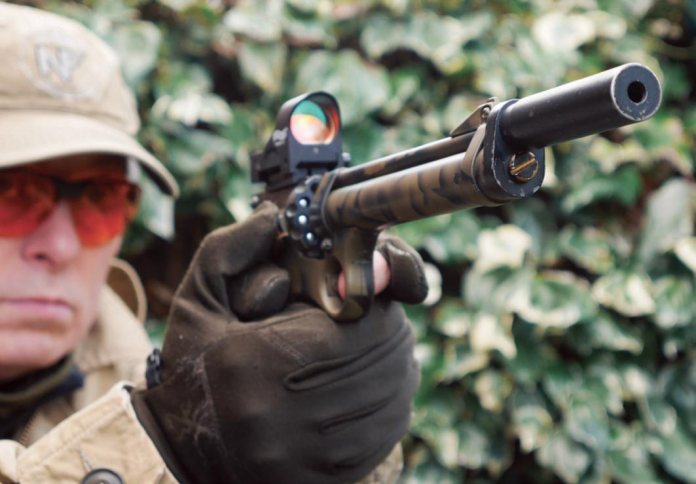
Jules Whicker selects a sextet of favourite guns from his curious collection…
I’m sure there are people who put their armoury together in a comprehensively rational manner. But I am not one of them; factors intervene. Opportunities and budgets expand and reduce. And then there are the outbreaks of spontaneous enthusiasm. In short, there are ways in which a gun cabinet is a kind of autobiography, not to mention a repository of treasured shooting memories. Here, then, are six snapshots from the album…
SHOTGUNS
There are few things better than a good day out with a shotgun, whether decoying, roost shooting, walking-up or standing on a peg. I enjoy the odd round of clays, too, although for me it’s always a substitute for a trip into the field. My 12-gauge holdings fall into two groups: comprise pragmatic pump-action, semi-auto and suppressed guns; and classic boxlock and sidelock side-by- sides (English and Spanish) in the middle, however, is my first pick: an Italian 20g O/U.
B. Rizzini RB Classic
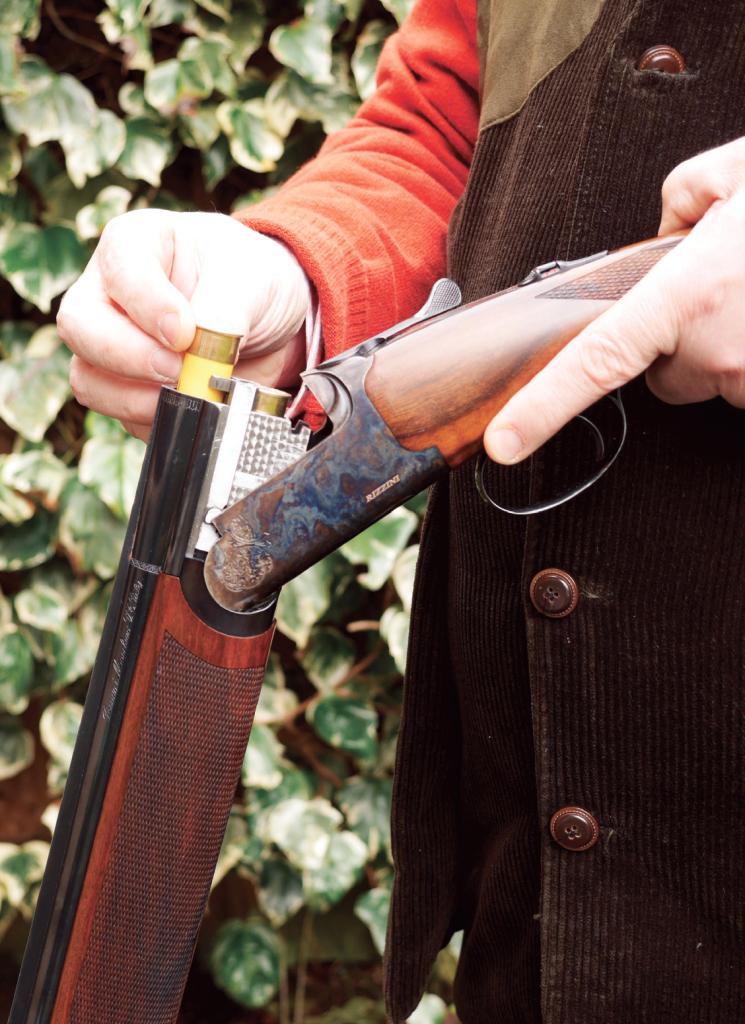
To me, a 12g O/U always feels BIG, whereas a 20g feels RIGHT, especially if it has long barrels. The Rizzini RB classic has all the other features I like too: solid sighting and mid ribs; a straight London-style forend and a rounded pistol grip, cut from a well-figured walnut blank and very tidily chequered; an elegant round action, sparsely engraved and beautifully colourcase- hardened; well-shaped triggers with a crisp break; and an understated top lever that is no bigger than it needs to be.
Buying new was too much of a luxury, so I kept my eye out and finally saw a nearly new gun at a very reasonable price at Stephen & Son. It didn’t have the 32-inch barrels I really wanted, but scored so highly on price and condition that I couldn’t let it pass. Stephane Dupille at S&S then did a lovely job of adjusting the gun to fit me, giving it just the right amount of cast, drop and pitch.
I love shooting it, and it often repays my affection. Earlier this year, therefore, I couldn’t have been happier when my host came over to say a generous word after a testing wild-pheasant drive and was surprised to find I’d brought my birds down with a 20g. The little Rizzini now wears that compliment like a medal around its neck.
George Fuller 12g pinfire

Made in 1865, the Fuller is by far my oldest gun. When I encountered it I’d never had a pinfire in my hands before, or heard of Fuller, but it was immediately clear to me that the man knew how to make a gun, and had clients who were prepared to pay for quality. Research showed Fuller held premises on the Strand and a royal warrant from Prince Albert, but also that he bought barrels from John Portlock in Birmingham and locks from John Stanton in Wolverhampton, and who knows how much of the rest of this “best London” gun was actually made in Brum!
With the barrels gauged at Holt’s and the gun pronounced fit to shoot, I added it to my SGC, obtained a black-powder licence and sourced some handsome brass pinfire cases and sundries from H & C Collections in France. Meanwhile, Sam Banner in Hartlebury expertly and inexpensively replaced a broken mainspring.
The heavy-heeled muzzleloader- style stock perfectly counterweights the 30-inch Damascus barrels, producing an immensely shootable gun. Albeit slow to reload, the gun is surprisingly fast in the hands and I’ve taken some super birds with it. Six jackdaws fell to nine shots on its inaugural outing; and (probably) its first game bird in over 100 years, a cock pheasant made an impression in my memory out of all proportion to the simplicity of the 20-yard shot that knocked it down and left a handful of gilded feathers floating in the pale sunlight of a December morning.
RIFLES
My rifles are also an odd lot. Part of this comes down to my being a left-hander who wants a right-handed gun as much as any right-hander wants a left-handed one: i.e. not at all.
Semi-Custom CZ527 in .204 Ruger
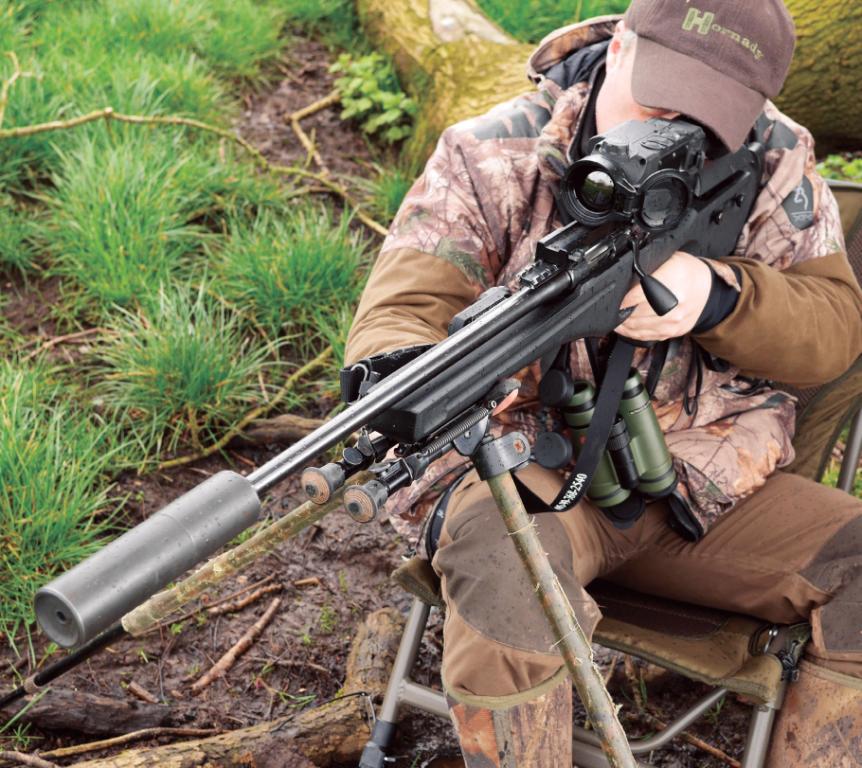
I wanted something compact, light-weight, light-recoiling, flatshooting and easily moderated for night shooting, and this tidy left-handed mini-Mauser in the .204 Ruger cartridge was just the job… with some modifications.
The original walnut sporter stock was replaced with a bespoke thumbhole number, designed and bedded by Danny Ryan (Staffordshire Synthetic Stocks). The height-adjustable buttpad and comb deliver perfect head alignment with night-vision optics, and the composite material is rugged and quiet. Side swivel studs and an SA80-style sling give a secure, comfortable carry when crossing obstacles or hauling bodies. The barrel was chopped to 18-inches and threaded for a slim over-barrel MAE moderator. Then Richard Pope of Swift Precision in Bromsgrove made and fitted extended Picatinny rail and the oversize bolt knob. Finally, I added a “trigger widener” from Osuna Products in Finland that enhanced the feel of the already crisp trigger.
With the advent of thermal, I replaced my HTH752 Gen 2 day/night scope with a Pulsar Trail XP50: a chunk of money I don’t in the least regret spending. The Trail makes the CZ a superlative tool for day-time squirrel-shooting as well as night-time fox-control.
Where straggly hedgerows follow narrow valleys, foraging squirrels can be spectacularly taken against the solid backstop of the opposite slope. The little CZ is also adept at taking foxes on the move. The rifle’s inherent handiness and perfect stock fit, the Trail’s low 1.6x native magnification, and the blistering speed of the 20-calibre projectile all combine to produce an intuitive sense of line and lead.
Krieghoff Super Drilling in 16g & 7x57R
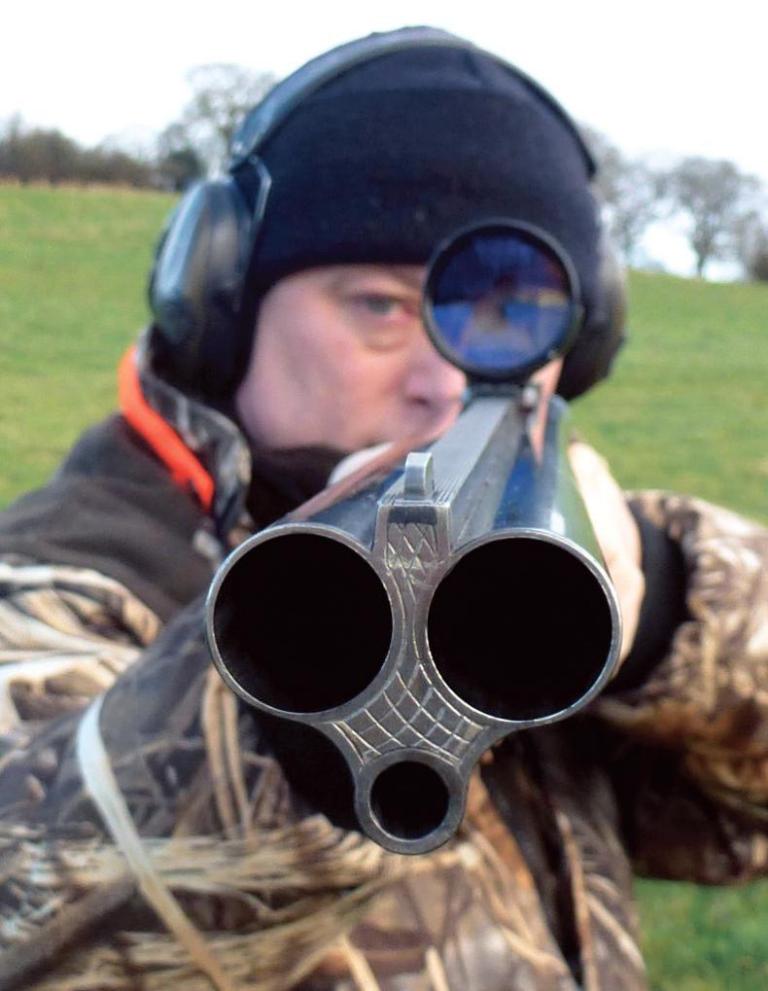
There are several kinds of drillings. The most commonly encountered are essentially side-by-side shotguns with an underslung rifled barrel, and for a versatile day out on your own ground they have no equal!
Drillings are also ideal for those who like a bit of Teutonic character and class, because the examples we find in the UK are mostly vintage guns from distinguished German names. The unfamiliarity and unfashionableness of the format also make them affordable. When I eventually found one in good condition, complete with its original scope (crucial, because off-the-shelf mounts aren’t available), and in a calibre designed for deer rather than pigs, I snapped it up. A couple of necessary repairs to the sears and trigger guard were expertly and swiftly done by Erwin Peumans at Alan Rhone’s in Wrexham.
The action pays homage to the English side-by-side: with a Scott top-lever, Greener third bite and cross-bolt, topmounted sliding safety, and double triggers. The Teutonic twist comes in offsetting the safety to free up the tang for a hefty “handspanner” that cocks/de-cocks the lock for the underslung rifle barrel. Cocking this also pops up a leaf sight in the rib: a neat party trick that reduces the risk of discharging the rifle barrel at an unsuitable target. Finally, the front trigger has a forward “set” position, giving the choice of a super-light release for precise shots, or a heavier standard pull for driven shooting.
The rib also incorporates the sockets for a Suhler clawmount system. The claws are on the half-rings brazed to the scope, a Kahles Helia 3-9x40 contemporary with the gun, which was completed in 1966. The Kahles has no windage turret, a German post reticle and a rather yellow tint; but otherwise the image is good, and it can be attached/removed silently, one-handed and with absolutely no loss of zero, so it makes no sense to separate these lifelong partners in order to fit a modern optic. A leather scope case also came with the gun. The case was in good condition, but the shoulder strap needed replacement. Jason Stocks-Young of the Diamond Awl Leather Workshop made me a perfect facsimile. Not cheap, but worth paying for.
Ammo mostly goes to 28g #5 Eley VIP Game and Norma 156g Oryx JSPs, which match the loads the sights were originally regulated to. 7x57R hand-loading is as simple as combining regular 7x57 dies with a shell-holder to fit the rimmed case head.
In the field, the Krieghoff is handy enough, as the short 24-inch tubes compensate for the extra weight of the rifled barrel. I’ve had fun with it on small pheasant days, but the 16g barrels are at their most rewarding when consoling oneself for an unsuccessful stak with some impromptu roost-shooting.
The Krieghoff has taken deer, too. One memorable outing focused on finding an injured roe buck seen on a trail camera. After a meticulous but futile stalk of its usual haunts, I had climbed into a high seat to watch the sunset, when the buck materialised serendipitously from the lengthening shadows, accompanied by a pair of does.
Tense minutes passed before I had a clear broadside shot; but despite the dwindling light I could still see the buck clearly through the Kahles. So, I settled the tip of the post behind its shoulder, set the trigger, and stroked the blade to send the bullet on its way. The buck dropped on the spot, yet despite the booming report from the unmoderated 7x57R, the does barely startled, even pausing briefly to puzzle over their former companion before browsing away into the bushes.
AIRGUNS
I’ll never forget how my first go with an HW35E transformed my expectations – of what an airgun could do. Similar epiphanies accompanied the acquisition of my first pre-charged pneumatic and my first FAC air rifle. The last couple of years have produced an even greater transformation, with the proliferation of high-powered PCPs and advances in the consistency and ballistic efficiency of new pellet and slug designs.
Harper Classic Wolf .22
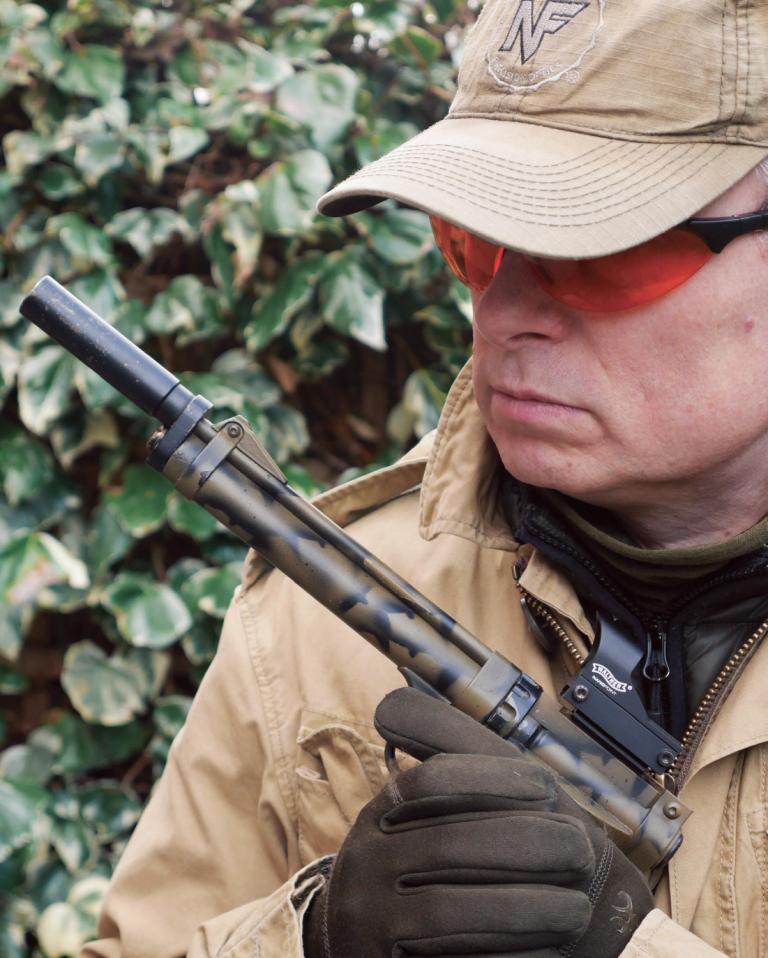
One of the very first PCP pistols, the Harper Classic Wolf was also a repeater, holding 11 pellets in .22 and blasting them out at up to 5.8 FPE, making it satisfying downrange as well as in the hand. You did have to cycle the cylinder manually, but with practice it was possible to achieve a gratifyingly rapid rate of fire.
Distinctive looks came from a slender brass micro-groove barrel and a moulded black polymer pistol grip with a circular trigger guard. Function was radical, too, as it was an all-electronic system, with a push-button trigger, a toggle switch with a red LED in place of a safety catch, and a 9V battery hidden in the grip. The slim air cylinder gave an amazing 50 shots per fill, and even more if you used the “secret” wheel in the grip to dial back the power.
Accessories included a silencer and a wire stock. The silencer attached to the forwardfacing filler valve thread, so had to be removed every time you needed air; but it worked pretty well, so you lived with it. I’d love to say my Wolf is pristine, but a well-intentioned yet poorlyexecuted customisation project at Sandwell Field Sports left it with a dodgy camo paint job and a damaged grip, and without the intended quick-fill valve and pushfit moderator. Fortunately, the pistol still worked as designed.
This mattered, because at the time most of my shooting took place in the vital six-metre gap between the front door of my flat and the pellet trap at the end of the hallway! In that environment any air pistol is welcome, and the Wolf was an indispensable companion.
By rights, Steve Harper’s little gem should have sired a long lineage of fast-firing, hard-hitting, electronic PCP pistols; but the dark cloud cast by Dunblane put paid to that, and to this day there’s nothing to match it.
FX Impact Mk2 .22 FAC
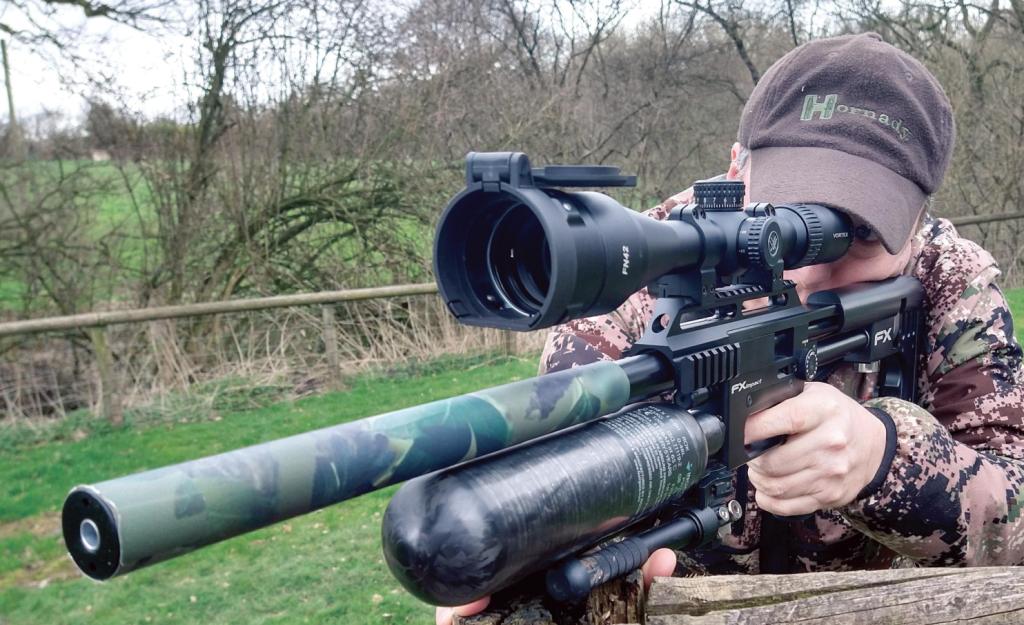
I almost gave this segment to my Daystate Mk4, which has given me a decade of service, taught me why an FAC air rifle is worth having, and accounted – in one unbelievably-awesome but tantalisingly-anticlimactic day – for a bag of 98 assorted corvids from a single tree. Unable to detect the hide or hear the shots, the birds just kept on coming. Habit? Bravado? Or sheer puzzlement at the mysterious force silently striking down their fellows?
Trouble is air rifles keep getting better… and my new FX Impact is more accurate, powerful, compact and versatile, and so frugal that it could have tackled that epic 98-head tally on a single fill and with air to spare.
I miss the sinuous lines of the Daystate’s walnut thumbhole stock and the refinement of its action block and bolt, which put the sharp-cornered angularity of the FX to shame; not to mention the Mk4’s dedicated left-handedness, an attribute FX are woefully indifferent to. The Impact’s lack of sling attachment points seems rather careless, too. But in the end what counts is its ability to land pellet after pellet on target at ever-increasing ranges and at impressive velocities with what always seems to be the merest puff of air. I have plans for it as well. An ambidextrous cocking block from Saber Tactical for starters.
I like to think I chart my own path with my gun choices, but with the Impact, it was my shooting buddy, James, who led the way. The decisive moment came towards the end of the year’s intense corvid campaign, when the surviving birds had learned to land much further from the yard before flighting in to feed in the clamp or the cow sheds.
Four crows were perched in a treetop 150m away. James passed up the shot, so I decided to have a go, if only to scare them off. I began by guesstimating the holdover and aiming for a branch well downwind of the crows. The shot missed the branch but knocked off a leaf, giving me a good elevation indicator and a rough idea of windage. To refine this I decided to aim high over the head of the upwind crow and see which of the four would duck as the pellet passed over it. It sounds daft, but it worked. So, I dropped my point of aim, applied the apparent windage, and squeezed the trigger. Hit square in the chest, the crow tumbled off its branch and fell stone dead to the ground.
Any fool can fluke a shot, but I had been able to watch each pellet cut the air and had been impressed enough by the stability and predictability I was seeing in the sighters to think it worth shooting for a score. With that shot, the Impact proved me right, and won me over.
Final thoughts
I hope you’ve enjoyed this eclectic “six of the best” from my gun cabinet. Each one has its place, its history and its memories. I reach for some far more often than others, but each time any of them comes out, they awake an eager anticipation of the pleasures the day will bring.
CONTACTS
Alan Rhone (Krieghoff)) alanrhone.com ASI (B. Rizzini): a-s-i.co.uk Braces of Bristol (Saber Tactical): bracesofbristol.com Daystate: daystate.com Diamond Awl Leather Workshop: diamondawl.co.uk Eley Hawk: eleyhawkltd H & C Collections: hc-collection.com Holt’s Auctioneers: holtsauctioneers.com JMS Sporting (MAE): jmssporting.com RUAG (Norma): ruag.co.uk Sam Banner: 07980 391 559 Sportsman Gun Centre (CZ firearms; FX Airguns): sportsmanguncentre.co.uk Staffordshire Synthetic Stocks: staffs-synthetic-stocks.com Stephen & Son (Stephane Dupille): stephenandson-gunmakers.co.uk Swarovski Optik UK (Kahles): uk.swarovskioptik.com Swift Precision Rifles (Ruchard Pope): 07739 689 871 Thomas Jacks (Pulsar): thomasjacks.co.uk
